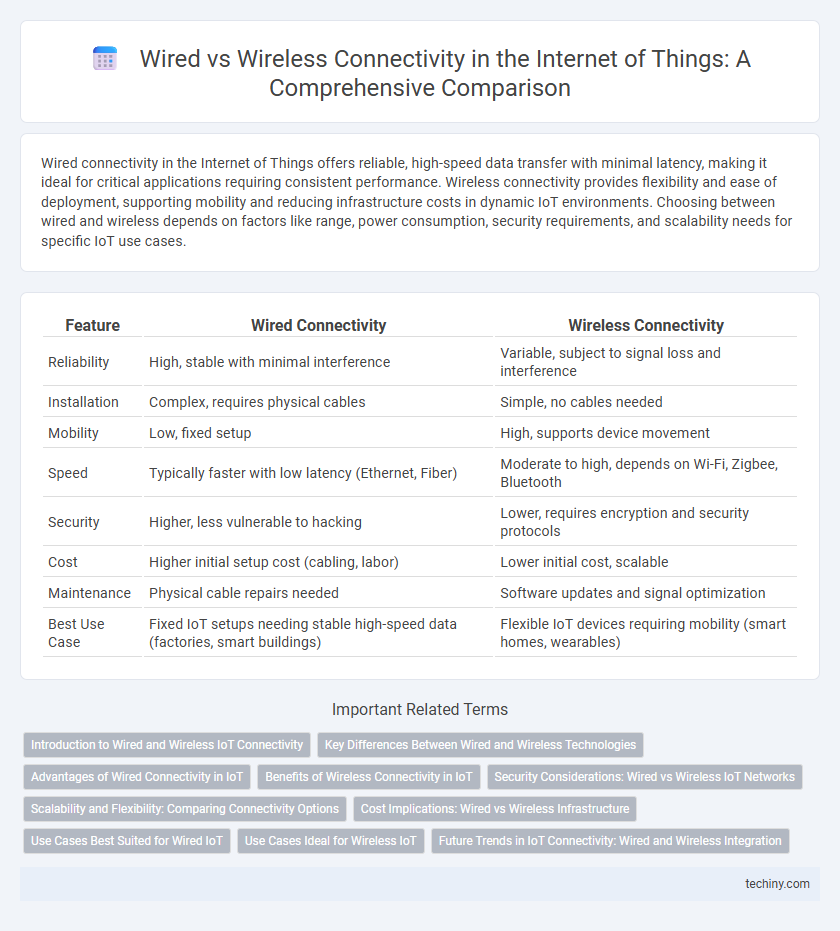Wired connectivity in the Internet of Things offers reliable, high-speed data transfer with minimal latency, making it ideal for critical applications requiring consistent performance. Wireless connectivity provides flexibility and ease of deployment, supporting mobility and reducing infrastructure costs in dynamic IoT environments. Choosing between wired and wireless depends on factors like range, power consumption, security requirements, and scalability needs for specific IoT use cases.
Table of Comparison
| Feature | Wired Connectivity | Wireless Connectivity |
|---|---|---|
| Reliability | High, stable with minimal interference | Variable, subject to signal loss and interference |
| Installation | Complex, requires physical cables | Simple, no cables needed |
| Mobility | Low, fixed setup | High, supports device movement |
| Speed | Typically faster with low latency (Ethernet, Fiber) | Moderate to high, depends on Wi-Fi, Zigbee, Bluetooth |
| Security | Higher, less vulnerable to hacking | Lower, requires encryption and security protocols |
| Cost | Higher initial setup cost (cabling, labor) | Lower initial cost, scalable |
| Maintenance | Physical cable repairs needed | Software updates and signal optimization |
| Best Use Case | Fixed IoT setups needing stable high-speed data (factories, smart buildings) | Flexible IoT devices requiring mobility (smart homes, wearables) |
Introduction to Wired and Wireless IoT Connectivity
Wired IoT connectivity relies on physical cables such as Ethernet and fiber optics to ensure stable, high-speed data transmission with low latency, making it ideal for industrial environments requiring consistent performance. Wireless IoT connectivity uses technologies like Wi-Fi, Bluetooth, and LoRaWAN to enable flexible and scalable device networking without physical constraints, suitable for dynamic or hard-to-reach locations. Both wired and wireless methods play crucial roles in IoT ecosystems, balancing factors like installation cost, range, bandwidth, and reliability according to specific application needs.
Key Differences Between Wired and Wireless Technologies
Wired connectivity in the Internet of Things (IoT) offers stable, high-speed data transmission with low latency, ideal for critical applications requiring consistent performance. Wireless connectivity provides flexibility and scalability, enabling easy deployment in dynamic or remote environments without the constraints of physical cabling. Key differences include signal reliability, installation complexity, bandwidth capacity, and susceptibility to interference, which influence the choice between wired Ethernet, fiber optics, Wi-Fi, Bluetooth, or cellular networks for specific IoT use cases.
Advantages of Wired Connectivity in IoT
Wired connectivity in IoT offers superior reliability and stable data transmission due to physical cables that minimize interference and signal loss. This method provides enhanced security as it reduces vulnerabilities associated with wireless signals, making it ideal for critical infrastructure and industrial automation. High-speed data transfer and low latency further support applications that demand real-time processing and consistent network performance.
Benefits of Wireless Connectivity in IoT
Wireless connectivity in IoT offers unparalleled scalability, enabling seamless integration of a vast number of devices without the constraints of physical cables. Enhanced mobility supports real-time data collection from dynamic environments, improving operational efficiency and responsiveness. Reduced installation and maintenance costs drive faster deployment and lower total cost of ownership, making wireless solutions ideal for expansive IoT networks.
Security Considerations: Wired vs Wireless IoT Networks
Wired IoT networks offer enhanced security through physical barriers that limit unauthorized access and reduce exposure to interference or hacking attempts common in wireless environments. Wireless IoT networks face greater vulnerability due to signal interception risks, requiring robust encryption protocols and frequent security updates to mitigate threats. Effective security strategies for IoT must balance the convenience of wireless connectivity with the inherent protection provided by wired infrastructures.
Scalability and Flexibility: Comparing Connectivity Options
Wired connectivity in IoT offers reliable scalability with high data transfer rates and consistent performance, making it ideal for large-scale deployments requiring stable connections. Wireless connectivity provides superior flexibility, enabling easy expansion and device mobility without the constraints of physical cables, which supports dynamic IoT environments. Balancing scalability and flexibility depends on the specific application needs, such as industrial automation favoring wired solutions and smart cities leveraging wireless networks for extensive device integration.
Cost Implications: Wired vs Wireless Infrastructure
Wired connectivity in IoT setups often entails higher upfront costs due to extensive cabling, installation labor, and physical infrastructure requirements that can escalate in complex environments. Wireless infrastructure, while reducing expenses on physical wiring, involves ongoing costs linked to spectrum licenses, security measures, and potential interference mitigation technologies. Choosing the optimal connectivity solution depends on balancing these cost implications with factors like network scalability, maintenance, and environmental constraints in IoT deployments.
Use Cases Best Suited for Wired IoT
Wired connectivity in IoT is best suited for industrial automation, smart manufacturing, and critical infrastructure monitoring due to its high reliability, low latency, and stable data transmission. Applications such as factory floor equipment, energy grid systems, and security surveillance benefit from the consistent performance and resistance to interference provided by Ethernet or fiber-optic connections. These environments demand secure, uninterrupted communication channels that wired IoT solutions reliably deliver.
Use Cases Ideal for Wireless IoT
Wireless connectivity in IoT is ideal for remote monitoring, smart agriculture, and asset tracking where mobility and flexible deployment are critical. Industrial automation and smart cities benefit from wireless IoT due to reduced installation costs and ease of scalability across large, dynamic environments. Wireless protocols like LPWAN, Zigbee, and LTE-M optimize power consumption and support long-range communication essential for widespread sensor networks.
Future Trends in IoT Connectivity: Wired and Wireless Integration
Future trends in IoT connectivity center on the seamless integration of wired and wireless networks to enhance performance, reliability, and scalability. Emerging technologies such as 5G, Wi-Fi 6E, and low-power wide-area networks (LPWAN) complement fiber optics and Ethernet to support diverse IoT applications with ultra-low latency and high bandwidth. Hybrid architectures enable intelligent edge devices to switch dynamically between wired and wireless modes, optimizing energy consumption and network resilience for smart cities, industrial automation, and autonomous systems.
Wired connectivity vs Wireless connectivity Infographic

 techiny.com
techiny.com